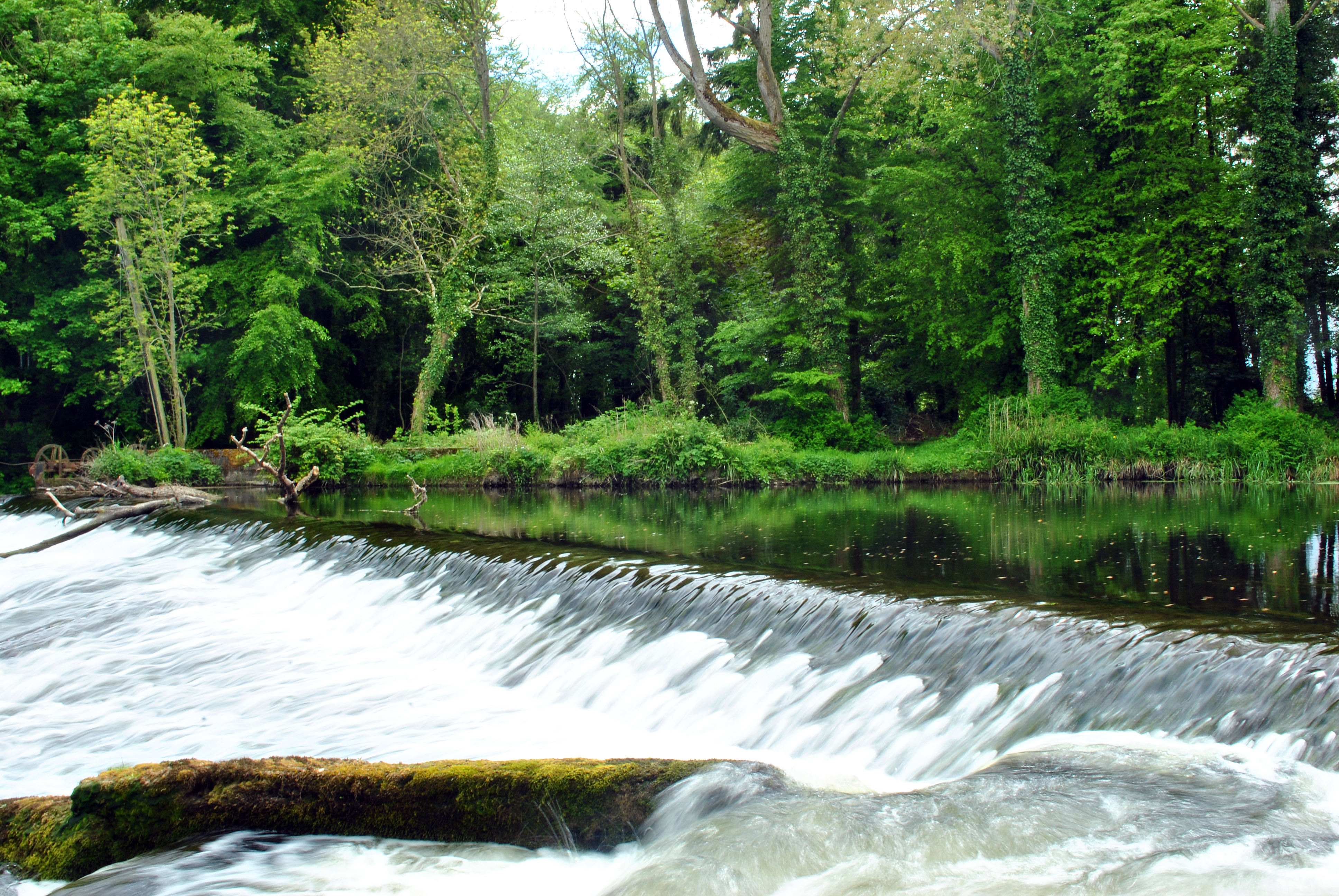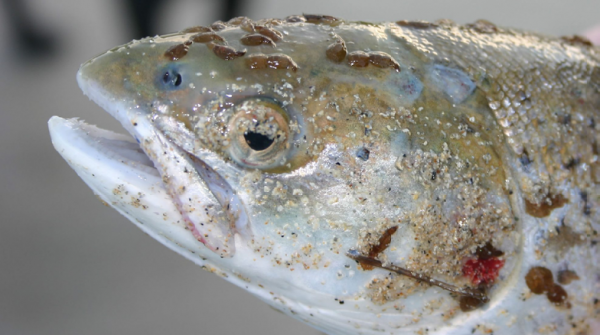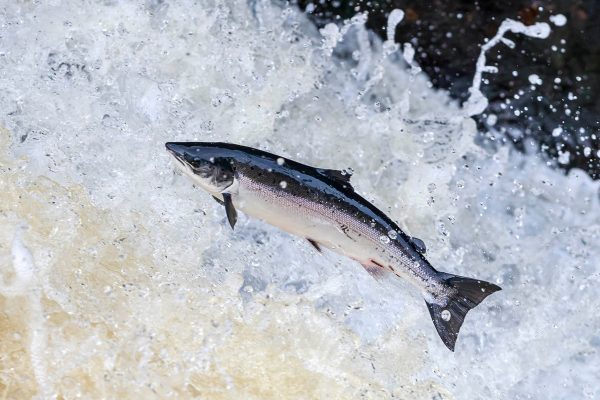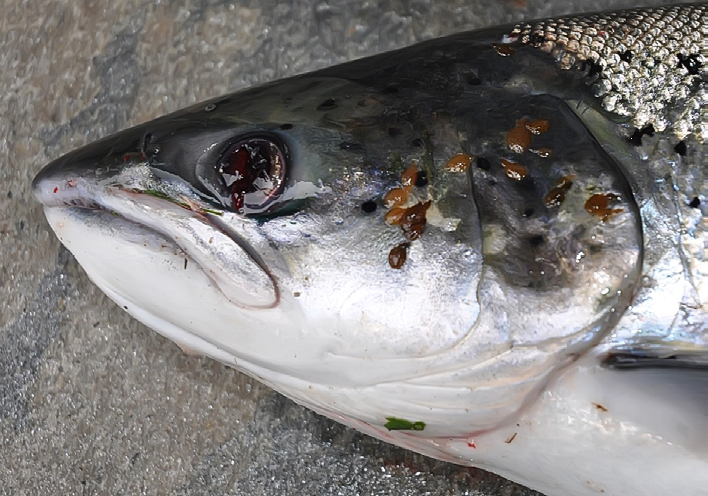Predation of Salmonids
Predation of salmonids, by birds and mammals in rivers, estuaries and on the high seas appears to be on the increase although data as to the abundance of predators and the significance of their impact is patchy. The anecdotal evidence, especially from rivers and estuaries, is hard to ignore, however.
Salmon Watch Ireland is acutely aware that predation in freshwater and in near coastal areas is viewed by stakeholders as an impediment to the optimum survival of salmonid juveniles. However we are cognisant that predation is a necessary part of the natural selective mechanisms to build a robust and self-sustaining salmonid stock.

Weirs and obstacles prove a happy hunting ground for predators. Adult and smolt migration is delayed by these barriers and increased predator residence is evident.
Predation pressure is a major part of the development of the salmonids life cycle in that it aids the “survival of the fittest” thus imparting genetic advantages to offspring that survive. A large part of Atlantic salmon behaviour is related to predator avoidance.
However there are certainly conditions which may mitigate against predation desirability on salmonid resources. The predation on adult stocks and juveniles which are at present compromised by other factors is of great concern.
Salmon Watch Ireland is looking to promote a policy of awareness of predation issues especially where they impact on vulnerable stocks and where adult salmon predation pressure is demonstrated to be an issue in driving population dynamics in particular catchments.
To illustrate the predation pressure salmonids face it is probably desirable to examine each stage of the life cycle.
In regard to predation on ova it is probably safe to assume that ova that are deposited in the gravel are relatively safe and that ova which are readily available might not survive anyway and in this case predation may not be a large issue in the overall dynamics of the particular salmon population. The main predators at this juncture are probably avian with other resident salmonids also impacting.
Salmon fry are vulnerable to trout and other piscivorous fish within systems and heavy predation may occur. Parr are affected by predation from certain predator fish including brown trout and pike. Avian predation is also a factor with Cormorants, various divers and Grey Herons particularly evident in nursery areas. However predation rates are lower than on newly emerging fry.
Smolts on their journey to sea must pass through a variety of habitats including lakes and reservoirs. Many obstacles face smolts where predators may congregate and predate large numbers of smolts. It is important to note that any obstacle which stops or slows migration is a potential bottleneck to migration which may lead to a build-up of smolts and thus an opportune area where both avian and piscivorous fish can predate large numbers of fish.
On entering estuarine water the post smolt faces a number of serious predation issues. Seals, bass, cod and other predatory fish congregate along with avian predators to feed on migrating smolts. Smolts also face an acclimatisation period on entering the marine environment and may not be as well adapted to avoid predators during this initial period.
One of the most worrying aspects of climatic change is that many near coastal areas may be affected by a change in abundance of prey items which may leave salmon smolts more vulnerable to predation. There is also the issue of migrating to sea at an earlier juncture than historically recorded thus suggesting a mis-match with optimum productivity periods at sea which may leave post smolts weak and increasingly vulnerable to predation.
The full marine environment poses problems but little is known of the exact nature that predation may play in the open marine environment.
The predation pressures on adult salmon returning to the near coastal area or estuaries is dependent on environmental conditions which might include low water which may impact on migration into freshwater thus allowing predation to take place. The largest impact on salmon stocks may be at this juncture as adult salmon lost are a direct impact on fish available to spawn.
Salmon Watch Ireland will certainly pursue a range of policies to protect vulnerable stocks from predation. However the most enduring and sensible way to promote a healthy and vibrant stock of salmon is to repair the habitat and remove bottlenecks to productivity and migration.
We would certainly suggest that some measures are introduced to alleviate avian predation on freshwater systems which are experiencing compromised salmon populations.
There are various ways of mitigating predator pressure either through lethal or non-lethal methods with licencing being the remit of the National Parks and Wildlife Service.
As with the majority of problems facing Atlantic salmon the over-riding problems may be caused by an imbalance in ecosystem function caused by man and as such we must try and remedy the situation through a range of policies.
To achieve a balanced ecosystem you certainly need some predators but a managed population of avian predators may help in achieving some balance. Removing the majority of predators may have undesired consequences and may prove extremely difficult.
It is interesting to note that the Atlantic Salmon Trust is presently examining the survival of salmon from river catchments to the marine environment and this may give some light on where predation has its most dominant effect and this will certainly inform our policies going forward.
Smolt Track – Atlantic Salmon Trust
There are provisions contained in the Wildlife Act 1976- As Amended to control protected wild animals or birds which are causing serious damage to a fishery. The relevant Section 42 is contained in following Legislation.
1976 Wildlife Act – As Amended
Licence Section 42 Wildlife Act






